CdSe量子点的尺寸依赖性荧光特性
IF 2.4
4区 物理与天体物理
Q3 PHYSICS, CONDENSED MATTER
引用次数: 0
摘要
利用吸收光谱、发射光谱和时间分辨光谱研究了三种不同尺寸硒化镉(CdSe)量子点的光学性质。吸收光谱和发射光谱揭示了量子点由于量子约束效应而发生的蓝移。测量了CdSe胶体量子点激子寿命的三个单独组分的贡献,并确定了它们的加权平均激子寿命。计算CdSe量子点的平均激子寿命时,包括与带边到价带跃迁有关的快速寿命分量(τ1)、与表面捕获态到价带或带边到价捕获态跃迁有关的中间寿命分量(τ2)和与表面捕获态到价捕获态跃迁有关的慢寿命分量(τ3)。研究表明,在所有大小的量子点中,带边跃迁对激子寿命的贡献更大。结果表明,对于小于玻尔半径的量子点,寿命随尺寸增大而增大。对于大于玻尔半径的量子点,这种趋势并不成立。这些发现为CdSe量子点的尺寸依赖光学特性提供了重要的见解,并对先进光电器件和其他尖端技术应用的发展具有重要意义。本文章由计算机程序翻译,如有差异,请以英文原文为准。
Size-dependent fluorescence properties of CdSe quantum dots
The optical properties of three different sizes of cadmium selenide (CdSe) quantum dots (QDs) were investigated using absorption, emission, and time-resolved photoluminescence spectroscopy. The absorption and emission spectra disclose the blue shift of a quantum dot due to quantum confinement effects. The contributions of the three individual components of the exciton lifetime of CdSe colloidal QDs were measured and their weighted average exciton life time was determined. A fast lifetime component () related to the band edge to valence band transition, an intermediate lifetime component () associated with the surface-trapped state to valence band or band edge to valence trapped state transition, and a slow lifetime component () associated with the surface-trapped state to valence trapped state transition are included in calculating the average exciton lifetime in CdSe QDs. The study demonstrates that the band-edge transition consistently contributes more significantly to the overall exciton lifetime across all QDs sizes. It reveals that the lifetime increases with size for QDs smaller than Bohr radius. The same trend does not hold for QDs larger than Bohr radius. These findings offer a critical insight into the size-dependent optical properties of CdSe QDs and hold significant implications for the development of advanced optoelectronic devices and other cutting-edge technological applications.
求助全文
通过发布文献求助,成功后即可免费获取论文全文。
去求助
来源期刊

Solid State Communications
物理-物理:凝聚态物理
CiteScore
3.40
自引率
4.80%
发文量
287
审稿时长
51 days
期刊介绍:
Solid State Communications is an international medium for the publication of short communications and original research articles on significant developments in condensed matter science, giving scientists immediate access to important, recently completed work. The journal publishes original experimental and theoretical research on the physical and chemical properties of solids and other condensed systems and also on their preparation. The submission of manuscripts reporting research on the basic physics of materials science and devices, as well as of state-of-the-art microstructures and nanostructures, is encouraged.
A coherent quantitative treatment emphasizing new physics is expected rather than a simple accumulation of experimental data. Consistent with these aims, the short communications should be kept concise and short, usually not longer than six printed pages. The number of figures and tables should also be kept to a minimum. Solid State Communications now also welcomes original research articles without length restrictions.
The Fast-Track section of Solid State Communications is the venue for very rapid publication of short communications on significant developments in condensed matter science. The goal is to offer the broad condensed matter community quick and immediate access to publish recently completed papers in research areas that are rapidly evolving and in which there are developments with great potential impact.
 求助内容:
求助内容: 应助结果提醒方式:
应助结果提醒方式:


